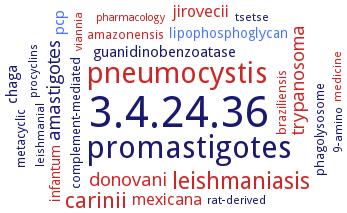3.4.24.36: leishmanolysin
This is an abbreviated version!
For detailed information about leishmanolysin, go to the full flat file.

Word Map on EC 3.4.24.36 
-
3.4.24.36
-
promastigotes
-
pneumocystis
-
leishmaniasis
-
carinii
-
donovani
-
trypanosoma
-
amastigotes
-
jirovecii
-
mexicana
-
chaga
-
pcp
-
guanidinobenzoatase
-
infantum
-
lipophosphoglycan
-
metacyclic
-
braziliensis
-
complement-mediated
-
phagolysosome
-
amazonensis
-
rat-derived
-
9-amino
-
tsetse
-
viannia
-
leishmanial
-
medicine
-
procyclins
-
pharmacology
- 3.4.24.36
- promastigotes
- pneumocystis
- leishmaniasis
- carinii
- donovani
- trypanosoma
- amastigotes
- jirovecii
- mexicana
-
chaga
- pcp
-
guanidinobenzoatase
- infantum
- lipophosphoglycan
-
metacyclic
- braziliensis
-
complement-mediated
-
phagolysosome
- amazonensis
-
rat-derived
-
9-amino
-
tsetse
- viannia
-
leishmanial
- medicine
-
procyclins
- pharmacology
Reaction
Preference for hydrophobic residues at P1 and P1' and basic residues at P2' and P3'. A model nonapeptide is cleaved at -Ala-Tyr-/-Leu-Lys-Lys- =
Synonyms
66 kDa surface metallopeptidase, Cell surface protease, glycoprotein 63, Glycoprotein gp63, gp63, GP63 metalloprotease, GP63 protein, GP63 surface metalloprotease, GP63 virulence protein, Leishmania metalloproteinase, Leishmania surface metalloprotease, leishmanolysin-like molecule, Major surface glycoprotein, major surface protease, major surface-metalloprotease, metalloprotease GP63, MSP, Promastigote surface endopeptidase, Promastigote surface protease, protective surface protease, Surface acid proteinase, surface leishmanolysin-like molecule, surface protease GP63, surface protein GP63, surface proteinase GP63, virulence factor major surface protease


 results (
results ( results (
results ( top
top





